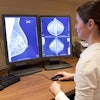Sunday, November 25 | 10:55 a.m.-11:05 a.m. | SSA02-02 | Room E450B
Contrast-enhanced digital mammography reduces unnecessary biopsies, according to a study being presented on Sunday morning.The results address the concern that one harm of breast cancer screening is its high rate of biopsy of benign lesions, particularly those categorized as BI-RADS 4A and 4B (findings with low or intermediate chance of being malignant).
A team led by Dr. Margarita Zuley of the University of Pittsburgh included data from 57 women with 60 lesions classified as BI-RADS 4A or 4B who underwent ultrasound, stereotactic, or digital breast tomosynthesis-directed biopsy between April 2016 and November 2017; the women had contrast-enhanced digital mammography (CEDM) before the biopsy was performed.
After digital breast tomosynthesis and ultrasound and before CEDM, 72% of lesions were classified as BI-RADS 4. But after CEDM, 35% of these were reclassified as BI-RADS 3, thus eliminating the need for a biopsy, Zuley and colleagues found.
"CEDM use during diagnostic evaluation of BI-RADS 4A or 4B lesions may result in a significant increase in [positive predictive value] with minimal impact on cancer diagnosis rates," the group concluded.




















